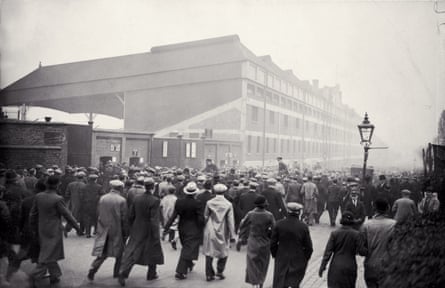Names that were once freely chosen – so freely that you hardly gave them a thought – now come with sums of money attached. Market principles operate. In north London, for example, Tottenham Hotspur FC has reportedly gone to considerable trouble and expense to persuade Transport for London to rename the local railway station after the club. The station, White Hart Lane, has been there since 1872; Spurs moved next door into a ground of the same name much later, in 1899. A pub, the White Hart, had been there long before either.
For all this time and more, the names of public places such as stations and sports grounds arrived as the gifts of geography or history. No longer. In Tottenham, a new stadium has recently been completed adjacent to the old one, and tomorrow the first proper game of football will be played on its turf. Crowd capacity has increased from 36,000 to 62,000 at a cost estimated between £400m and £800m, according to how much non-building work you include. What the club needs, and so far hasn’t found, is a business that will defray some of this expense by buying the naming rights. At present the new ground goes by the name of the Tottenham Hotspur Stadium, but this is temporary. The club needs to fit another word in there, somehow: Diageo, Aviva, Nike, Sony, Topshop – that kind of thing.
How renaming the railway station Tottenham Hotspur helps achieve this is difficult to understand, but it has, apparently, become crucial to the strategy. According to a Guardian report, TfL wanted £11.7m to change the name for a 10-year period (renewable thereafter, presumably), and another £3m for the new signage and the necessary adjustments to maps and timetables. Spurs has contested this sum, it would seem successfully. Any decision to proceed will be subject to public consultation.
There is already some uneasiness. Some fear that the words Tottenham Hotspur could be legally defined as a brand as well as a football side, setting a precedent for profitable coinages such as “Virgin Euston” and “Knightsbridge Home of Harrods”. In the Guardian, the letter-writer, social historian and Tottenham resident Keith Flett described the name change as “another attempt by corporate interests to makeover and rebrand … a vibrant multicultural working-class area with a strong sense of community”.
He may be right. Then again, he may have gone too far. In 1932, the Arsenal supremo Herbert Chapman successfully lobbied London Transport to change the name of a Piccadilly line stop from Gillespie Road to Arsenal (Highbury Hill), to advertise its proximity to a club that had moved north of the Thames from Woolwich only 20 years before, and was enjoying the first seasons in a decade of success that made it the most celebrated side in England. The station dropped the suffix to become Arsenal pure and simple somewhere around 1960, but it’s hard to see how the station’s new sporting identity affected the people who lived around it one way or the other.

Today the station’s bourgeois aspects include lavender-tinted tiles – a rarity in the underground – and in the entrance hall a jug of flowers and an informal lending library: a few shelves of books that commuters are encouraged to borrow. But these homely touches owe nothing to rebranding exercises and everything to the volunteer spirit of passengers and staff.
I’m pleased to live near such a place; I’ve always liked stations, and in particular the names they carried to distinguish one from another in an age of Victorian profusion, when the lines of rival railway companies would serve the same town. Greenock, to choose randomly, was served until the late 1950s by Greenock Central, Greenock West, Greenock Lynedoch, Upper Greenock and Greenock Princes Pier; while Farnworth in Lancashire, where I was born, had stations with names that might have come from The Pilgrim’s Progress. Moses Gate and Plodder Lane were each a 10- or 15-minute walk from our house; Farnworth and Halshaw Moor stood only slightly further off. To use Plodder Lane to reach Bolton Great Moor Street or Manchester Exchange had become eccentric behaviour by 1952 – the trains were fewer and slower than those via Moses Gate– but my brother’s railway enthusiasm sometimes carried us off down that line to the glazed and empty concourses of termini that wouldn’t long survive.
But even then, a few stations were named after brands rather than places. Some were obscure. Daimler Halt, near Coventry, opened to the public in 1956 and closed for want of traffic nine years later; it had been built in the first world war solely for use by employees of the Daimler company. In Kent, Uralite Halt on the Hundred of Hoo branch took workers and other interested parties to and from the British Uralite factory until its closure in 1961. (The fireproofing material uralite had been invented c1900, perhaps in the Urals, by a Russian colonel of artillery.) In terms of toponymy, branded goods made their most permanent impact in Scotland, where at Clydebank in 1885 the American company Singer established what was the world’s biggest sewing machine factory, with a workforce that at its peak in the early 1960s reached 16,000. Special trains took them to and from their shifts to a station called Singer, which still survives, even though the original reasons for its existence vanished 40 years ago. Will a station ever be named after a factory again? Outside China, it seems unlikely.
Perhaps the last of them to open in this country (in 1978) was IBM, where trains stopped every hour, in recent years quite pointlessly, on their way between Glasgow and the Clyde coast. IBM opened a plant here making typewriters and office equipment in the 1950s, switching to servers and laptops when less sophisticated manufacturing moved overseas to Hungary and the far east. Situated on the edge of Greenock, where shipyards as well as railway stations were closing, the factory represented what Scotland thought of as its industrial future. IBM’s workshops, office blocks and car parks spread further and further along the Spango Valley, conquering the green fields on the valley floor just as collieries once did in south Wales.
In 1990 it was flourishing; in 2017 it was dead. Nothing of it, not even a ruin, now survives, though the trains went on calling until December last year. The doors would slide open, but no ghostly horde of computer workers ever appeared. In the silence my brother, who often came that way, adapted Edward Thomas: “The electrics purred. Somebody swore. No one left and no one came / On the bare platform. What I saw / Was IBM – only the name …”
Tottenham Hotspur is a brand devoted to pleasure and has no manufacturing attached. Its trains will always be full.

